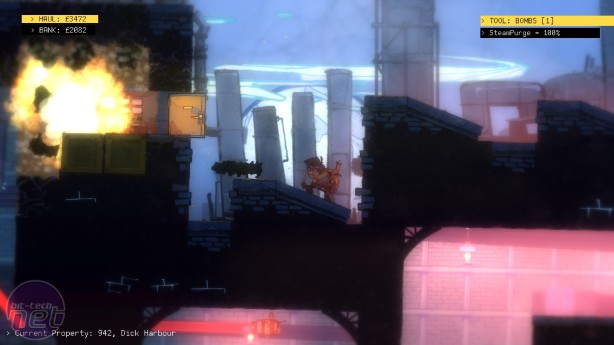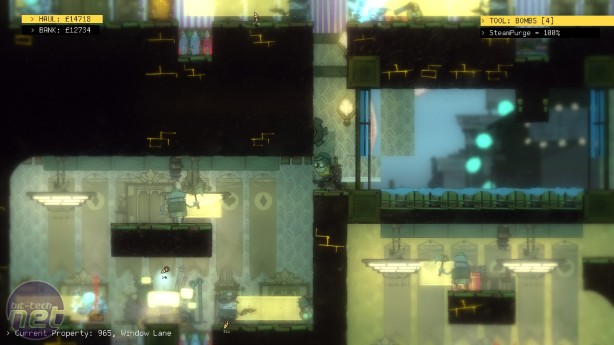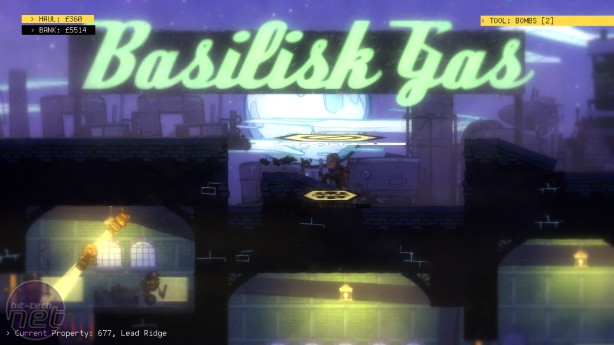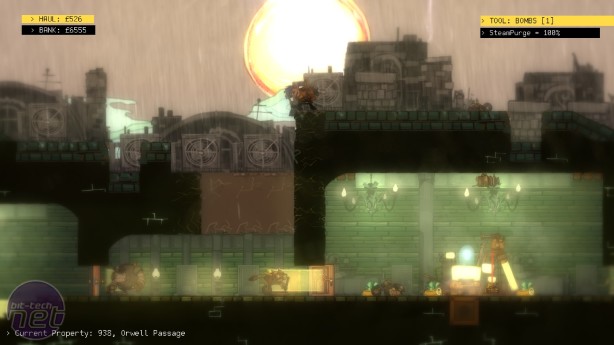
What results is a fascinating, thrilling, and sometimes heartbreaking blend of sprightly platforming and amorphous, underhand tactics. I always start out with the intention of casing the joint. I scout the windows and the rooftop to get a general overview of the building and what it contains. Sometimes though, the game's dynamic levels deny this opportunity, perhaps because you can't reach an overhanging ledge, or because there are guards sat outside a window you need to pass. Other times you might start a level and one of the computers you need to hack for the big bucks will be right there, tempting you to throw caution to the wind, and adopt a more smash 'n' grab approach.
As your robberies take you from tumbledown slums and neon-drenched warehouses to more extravagant mansions and casinos, the risks increase with the rewards. The simple steam-powered bobbies that patrol the earlier missions join forces with centipede-like automatons that are essentially moving spike-traps, spindly brain-in-a-jar cyborgs that can hear every move you make, and shotgun-wielding toffbots that preside over their estates with avaricious contempt for those thieving lower classes. The way the Swindle escalates is as impressive as it is intimidating, although sometimes the number of obstacles the random seed crams into a single room verges on the ridiculous.
That said, it's surprising how often you can crack even the hardest nut, especially once you've bought a few gadgets with your illicit gains. Bombs enable you to create your own entrances and exits to rooms, while the steam-purge provides a few precious seconds of cover, perfect for hacking a computer in a room watched by a camera. The most satisfying moments in the Swindle come when you prod a particular room from several angles, and successfully locate the one from which it is most vulnerable.
Timing your purchases appropriately is crucial. Alongside gadgets and abilities, unlocking the next tier of heists also costs money, and you don't want to be buying equipment before you need it, else you'll spend another five or ten heists scraping together the cash to move to the next stage. Initially 100 days seems like all the time in the world, but after a run of busts that number starts to seem worryingly small. Plus, the last mission need to be paid for every time you attempt it, so you really want to have a comfy time-cushion prior to that final run.
Letting the player see potential failure from such a distance is a bold move by Size Five, and it isn't a mirage either. In fact, should you pull off the Swindle within your first 100 days, I will tip my hat to you. Then I will eat it, because you won't. Indeed, if you particularly struggle with failure or frustration, you should probably avoid the Swindle like a toilet full of wasps. Having said that, it plays very quickly. Most heists last no longer than a couple of minutes, and if you do need to restart, discovering how far your stealing skills have progressed is immensely satisfying.
There are some more definite problems. Aesthetically the game is mostly a delight. The art style is bright and lively, complimented by an upbeat soundtrack that lends a subtle pace to your pilfering. Oh, and I spent way too long breaking into warehouses just so I could read their wonderful randomly generated names. Unfortunately, the screen is layered with a smoggy film effect that makes me feel like I have cataracts. It seems odd to take all that brilliant art and then slightly blur it out, and I didn't particularly appreciate it.
Also, while the Swindle generally does an excellent job at emphasising both your achievements and your mistakes, there are a couple of instances where that comes undone. Occasionally an enemy will appear who starts draining money from your bank account. I think this is intended as a counter to the Bug, which you can place on computers to siphon money over a number of missions. Having an enemy who rocks up to steal it back prevents you lingering around levels to generate more money for yourself. Frankly though I think both of these elements fly in the face of the game's overarching design, whereby you act and the game responds.
But they are merely elements, rather than fundamental issues at either a mechanical or conceptual level, and I think they stand out to me because otherwise the Swindle places the emphasis of action on you so well. Aside from the aforementioned flaws, it never pushes you into anything. Hence every brilliant score is yours to own, as is every embarrassing farce. It's the most honest game about nicking stuff I've ever played. You'll cheer and you'll curse. You'll punch the air and you'll punch the desk. But unlike the residents of the Swindle's vision of London, you'll never feel cheated.
As your robberies take you from tumbledown slums and neon-drenched warehouses to more extravagant mansions and casinos, the risks increase with the rewards. The simple steam-powered bobbies that patrol the earlier missions join forces with centipede-like automatons that are essentially moving spike-traps, spindly brain-in-a-jar cyborgs that can hear every move you make, and shotgun-wielding toffbots that preside over their estates with avaricious contempt for those thieving lower classes. The way the Swindle escalates is as impressive as it is intimidating, although sometimes the number of obstacles the random seed crams into a single room verges on the ridiculous.
That said, it's surprising how often you can crack even the hardest nut, especially once you've bought a few gadgets with your illicit gains. Bombs enable you to create your own entrances and exits to rooms, while the steam-purge provides a few precious seconds of cover, perfect for hacking a computer in a room watched by a camera. The most satisfying moments in the Swindle come when you prod a particular room from several angles, and successfully locate the one from which it is most vulnerable.
Timing your purchases appropriately is crucial. Alongside gadgets and abilities, unlocking the next tier of heists also costs money, and you don't want to be buying equipment before you need it, else you'll spend another five or ten heists scraping together the cash to move to the next stage. Initially 100 days seems like all the time in the world, but after a run of busts that number starts to seem worryingly small. Plus, the last mission need to be paid for every time you attempt it, so you really want to have a comfy time-cushion prior to that final run.
Letting the player see potential failure from such a distance is a bold move by Size Five, and it isn't a mirage either. In fact, should you pull off the Swindle within your first 100 days, I will tip my hat to you. Then I will eat it, because you won't. Indeed, if you particularly struggle with failure or frustration, you should probably avoid the Swindle like a toilet full of wasps. Having said that, it plays very quickly. Most heists last no longer than a couple of minutes, and if you do need to restart, discovering how far your stealing skills have progressed is immensely satisfying.
There are some more definite problems. Aesthetically the game is mostly a delight. The art style is bright and lively, complimented by an upbeat soundtrack that lends a subtle pace to your pilfering. Oh, and I spent way too long breaking into warehouses just so I could read their wonderful randomly generated names. Unfortunately, the screen is layered with a smoggy film effect that makes me feel like I have cataracts. It seems odd to take all that brilliant art and then slightly blur it out, and I didn't particularly appreciate it.
Also, while the Swindle generally does an excellent job at emphasising both your achievements and your mistakes, there are a couple of instances where that comes undone. Occasionally an enemy will appear who starts draining money from your bank account. I think this is intended as a counter to the Bug, which you can place on computers to siphon money over a number of missions. Having an enemy who rocks up to steal it back prevents you lingering around levels to generate more money for yourself. Frankly though I think both of these elements fly in the face of the game's overarching design, whereby you act and the game responds.
But they are merely elements, rather than fundamental issues at either a mechanical or conceptual level, and I think they stand out to me because otherwise the Swindle places the emphasis of action on you so well. Aside from the aforementioned flaws, it never pushes you into anything. Hence every brilliant score is yours to own, as is every embarrassing farce. It's the most honest game about nicking stuff I've ever played. You'll cheer and you'll curse. You'll punch the air and you'll punch the desk. But unlike the residents of the Swindle's vision of London, you'll never feel cheated.
-
Overall85 / 100


MSI MPG Velox 100R Chassis Review
October 14 2021 | 15:04













Want to comment? Please log in.